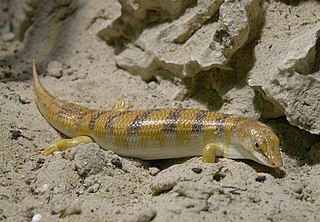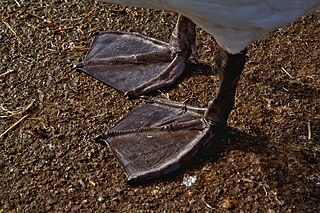
A fin is a thin component or appendage attached to a larger body or structure. Fins typically function as foils that produce lift or thrust, or provide the ability to steer or stabilize motion while traveling in water, air, or other fluids. Fins are also used to increase surface areas for heat transfer purposes, or simply as ornamentation.

Snakes are elongated, limbless, carnivorous reptiles of the suborder Serpentes. Like all other squamates, snakes are ectothermic, amniote vertebrates covered in overlapping scales. Many species of snakes have skulls with several more joints than their lizard ancestors, enabling them to swallow prey much larger than their heads. To accommodate their narrow bodies, snakes' paired organs appear one in front of the other instead of side by side, and most have only one functional lung. Some species retain a pelvic girdle with a pair of vestigial claws on either side of the cloaca. Lizards have independently evolved elongate bodies without limbs or with greatly reduced limbs at least twenty-five times via convergent evolution, leading to many lineages of legless lizards. These resemble snakes, but several common groups of legless lizards have eyelids and external ears, which snakes lack, although this rule is not universal.

Skinks are lizards belonging to the family Scincidae, a family in the infraorder Scincomorpha. With more than 1,500 described species across 100 different taxonomic genera, the family Scincidae is one of the most diverse families of lizards. Skinks are characterized by their smaller legs in comparison to typical lizards and are found in different habitats except arctic and subarctic regions.

Monitor lizards are lizards in the genus Varanus, the only extant genus in the family Varanidae. They are native to Africa, Asia, and Oceania, and one species is also found in the Americas as an invasive species. About 80 species are recognized.

Scincus is a genus of skinks, lizards in the family Scincidae. The genus contains four or five species, all of which are typical desert inhabitants, living in sandy and dune-like areas with a hot and dry climate. Species in the genus Scincus can be found from Arabia to the Sahara desert.

Sidewinding is a type of locomotion unique to snakes, used to move across loose or slippery substrates. It is most often used by the Saharan horned viper, Cerastes cerastes, the Mojave sidewinder rattlesnake, Crotalus cerastes, and the Namib desert sidewinding adder, Bitis peringueyi, to move across loose desert sands, and also by Homalopsine snakes in Southeast Asia to move across tidal mud flats. Any number of caenophidian snakes can be induced to sidewind on smooth surfaces, though the difficulty in getting them to do so and their proficiency at it vary greatly.

Animal locomotion, in ethology, is any of a variety of methods that animals use to move from one place to another. Some modes of locomotion are (initially) self-propelled, e.g., running, swimming, jumping, flying, hopping, soaring and gliding. There are also many animal species that depend on their environment for transportation, a type of mobility called passive locomotion, e.g., sailing, kiting (spiders), rolling or riding other animals (phoresis).

Fish locomotion is the various types of animal locomotion used by fish, principally by swimming. This is achieved in different groups of fish by a variety of mechanisms of propulsion, most often by wave-like lateral flexions of the fish's body and tail in the water, and in various specialised fish by motions of the fins. The major forms of locomotion in fish are:
The eastern skink, also commonly known as the Arabian sand skink and the eastern sand fish, is a species of lizard in the skink family (Scincidae).
Many vertebrates are limbless, limb-reduced, or apodous, with a body plan consisting of a head and vertebral column, but no adjoining limbs such as legs or fins. Jawless fish are limbless but may have preceded the evolution of vertebrate limbs, whereas numerous reptile and amphibian lineages – and some eels and eel-like fish – independently lost their limbs. Larval amphibians, tadpoles, are also often limbless. No mammals or birds are limbless, but some feature partial limb-loss or limb reduction.

The wildlife of Algeria is composed of its flora and fauna. Mountains, chotts, wetlands, and grassy desert-like regions all support a wide range of wildlife. The most commonly seen animals include the wild boars, jackals, and gazelles, although it is not uncommon to spot fennecs and jerboas. Leopards and cheetahs are seldom seen.

Scincomorpha is an infraorder and clade of lizards including skinks (Scincidae) and their close relatives. These include the living families Cordylidae, Gerrhosauridae, and Xantusiidae, as well as many extinct taxa. Other roughly equivalent terms include the suborder Scinciformata, or the superfamily Scincoidea, though different authors use these terms in a broader or more restricted usage relative to true skinks. They first appear in the fossil record about 170 million years ago, during the Jurassic period.

Oceanic dispersal is a type of biological dispersal that occurs when terrestrial organisms transfer from one land mass to another by way of a sea crossing. Island hopping is the crossing of an ocean by a series of shorter journeys between islands, as opposed to a single journey directly to the destination. Often this occurs via large rafts of floating vegetation such as are sometimes seen floating down major rivers in the tropics and washing out to sea, occasionally with animals trapped on them. Dispersal via such a raft is sometimes referred to as a rafting event. Colonization of land masses by plants can also occur via long-distance oceanic dispersal of floating seeds.

Undulatory locomotion is the type of motion characterized by wave-like movement patterns that act to propel an animal forward. Examples of this type of gait include crawling in snakes, or swimming in the lamprey. Although this is typically the type of gait utilized by limbless animals, some creatures with limbs, such as the salamander, forgo use of their legs in certain environments and exhibit undulatory locomotion. In robotics this movement strategy is studied in order to create novel robotic devices capable of traversing a variety of environments.

Certain species of fish and birds are able to locomote in both air and water, two fluid media with very different properties. A fluid is a particular phase of matter that deforms under shear stresses and includes any type of liquid or gas. Because fluids are easily deformable and move in response to applied forces, efficiently locomoting in a fluid medium presents unique challenges. Specific morphological characteristics are therefore required in animal species that primarily depend on fluidic locomotion. Because the properties of air and water are so different, swimming and flying have very disparate morphological requirements. As a result, despite the large diversity of animals that are capable of flight or swimming, only a limited number of these species have mastered the ability to both fly and swim. These species demonstrate distinct morphological and behavioral tradeoffs associated with transitioning from air to water and water to air.

The webbed foot is a specialized limb with interdigital membranes (webbings) that aids in aquatic locomotion, present in a variety of tetrapod vertebrates. This adaptation is primarily found in semiaquatic species, and has convergently evolved many times across vertebrate taxa.
Daniel Ivan Goldman is an experimental physicist regarded for his research on the biomechanics of animal locomotion within complex materials. Goldman is currently a professor at the Georgia Institute of Technology School of Physics, where he holds a Dunn Family Professorship.

The broad-banded sand-swimmer or Richardson's skink is a species of skink found in Australia.

Auke Jan Ijspeert is a Swiss-Dutch roboticist and neuroscientist. He is a professor of biorobotics in the Institute of Bioengineering at EPFL, École Polytechnique Fédérale de Lausanne, and the head of the Biorobotics Laboratory at the School of Engineering.

















